SEMA News - February 2010
Expert Insights Into Tire and Wheel Markets and Innovations
 |
|
|
“U.S. replacement passenger tires were expected to fall 6% in 2009 but could rebound in 2010 by about 3%, depending on the economy,” said David Zielasko, editor and vice president/publisher of Tire Business. |
|
Changing Tires
Because tires are a wear item, the replacement industry is obviously huge. Price, tread life, traction, size and speed ratings are all high on the list of considerations for consumers, and a change in wheels may also be undertaken when tires are replaced. As new technologies come on line and economic conditions create or change markets, the wheel and tire industry shifts to provide innovative products and accommodate consumer needs. The increasing emphasis on climate change and pollution has brought about something of a revolution in the industry.
“Most tire manufacturers are launching low-rolling-resistance products, which offer improved fuel efficiency,” said David E. Zielasko, editor and vice president/publisher of Tire Business. “Tire companies are also experimenting with—and, in some cases, already offering—tires manufactured using more environmentally friendly materials and chemicals.”
Those efficiencies and environmental enhancements are coming about through both tread design and the use of different manufacturing materials.
 |
|
|
Many tire companies are promoting the use of winter tires as opposed to all-season tires in northern regions of the United States, said David Zielasko. Winter performance tires, such as Falken’s Eurowinter HS439, provide superior grip on ice and snow. Courtesy of Tire Business |
|
Unfortunately, Smith pointed out, there is no universally accepted way to grade tire fuel efficiency, although the National Highway Traffic Safety Administration is said to be working on one. While they wait, tire manufacturers have been treading lightly on their fuel-efficiency claims to avoid entanglements with consumer groups or the government.
On the enthusiast side of the street, compounds seem to be the magic word. According to David Freiburger, editor-in-chief of Hot Rod and Hot Rod Deluxe magazines, more makers are getting involved in drag-specific, DOT-approved street radials, changing over from longer-wearing streetable models to those that are super gummy and provide nearly the same performance as a drag slick.
“While drag radials for 15-inch wheels are the performance standard in the street-car drag-racing world, we are seeing more and more expansion into models for 18-inch and larger wheels for OE applications, such as Corvettes, where the owner wants a sticky tire but can’t run small-diameter wheels because they will not fit over the stock brakes,” Freiburger said. “There’s also the Pro Touring market, which has matured to the point where performance handling radials and even specific big-track and autocross tires are being consumed by musclecar builders. In the retro market covered by Hot Rod Deluxe, Coker Tire is on top of the heap with its reproduction vintage tires and its new radial that looks like a bias-ply.”
Tire Review’s Smith said that the hot-rod market is a great one to be in right now for tire retailers because it is so well sheltered.
“These guys are in love with what they drive,” he said. “They’re not casual consumers. They’re intensely interested in their hobby and their craft. Spending levels may ebb and flow based on the economy, but you’re not going to see the whole segment just disappear overnight like we saw with the tuner segment.”
 |
|
Interchangeable bezels—such as a watch bezel—come in multiple colors, including hot pink and a glow-in-the-dark model. Courtesy of WTW Corp. |
 |
| Wheels such as this Spezia-5 by Gianelle can be modified with colored bezels as well as spoke caps in chrome or a matte-black finish. Courtesy of WTW Corp. |
The turbulence in the tuner segment is one indicator of how the automotive universe has suffered during the recession, and that’s not likely to change much for tire dealers in the coming months. Zielasko said that dealers will see stiffer competition in 2010 from larger tire chains and non-traditional outlets that have gobbled up smaller independents. In addition, car dealerships are taking a more aggressive approach to selling tires along with other types of accessories. Even so, Bob Ulrich, editor of Modern Tire Dealer magazine, pointed out that there is pent-up demand for tires as people hold on to vehicles longer and spend their money on maintenance of used vehicles rather than buying new. Ulrich also said, however, that the demand will be mitigated somewhat because tires will cost more than they did in 2009.
“There are two reasons,” he said. “Shortages in entry-level tires due to a 35% tariff on China-made consumer tires and rising raw material costs that will lead to higher prices across the board.”
In addition, tire manufacturers had been cleaning out inventory for eight months while trimming production, which will contribute to the rise.
 |
|
|
In the performance category, more makers are getting involved in drag-specific, DOT-approved street radials, such as this Hankook Ventus Z214 symmetrically designed semi-slick tire. |
|
“The greatest opportunity for tire manufacturers is to fill the void created by the Chinese tire tariff,” Zielasko said. “This is primarily in the entry-level segment—tires 15 inches in rim diameter and below. Tire makers will also gain from selling higher-margin tires, such as those with higher speed ratings; rim diameters that are 17 inches and higher; and those with special qualities, such as winter and eco tires.”
On the topic of sizing, Smith and others believe that the days of ultra-tall plus sizes are coming to an end and that diameters will return to the more moderate 15-, 17- and 18-inch realm. He also noted that the tire market will change as vehicle sales shift somewhat from light trucks to smaller crossovers and more fuel-efficient vehicles.
“A lot of people are waiting to see how the public reacts to these new offerings,” he said. “If the market goes crazy for the Dodge/Fiat 500, the Chevy Volt and these vehicles that have been heavily touted as being incredibly fuel efficient, that’s going to tell the tire makers a lot about how they’ve got to react. Dealers need to monitor those activities, just as they also need to be very judicious about inventory levels, ensuring that they’ve got a ready supply. If that means that you’ve got to use a couple of additional distributors in your area to meet your needs, then that’s what you’ve got to do. Cash is going to continue to be king in 2010, and a large part of that is not tying up a ton of dollars in inventory.”
For tire manufacturers, the challenge will be to maintain profitability in a market that’s shrunk, Zielasko said, citing statistics from the Rubber Manufacturers Association (RMA).
“U.S. replacement passenger tires were expected to fall 6% in 2009 but could rebound in 2010 by about 3%, depending on the economy,” he explained. “Light-truck tire replacement shipments were predicted to fall 11% in 2009, with no improvement for 2010. Overall, the RMA projects tire shipments to fall 13% in 2009, including commercial tires, but to rebound by nearly 6% in 2010.”
The Wheel Deal
 |
|
|
Design and color remain the soul of innovation for wheel manufacturers, including inserts, colored bezels, relief graphics and new spoke configurations. |
|
“The trend in design is to personalize the wheels,” he said, “adding your own touch to your vehicle by adding a colored bezel such as one from our Koko Kuture line in various colors or by custom painting the spoke caps of the wheels the same color as your car. One-piece forged wheels are also a new trend for many companies, although mine have had them available for years and it’s a limited application. And plastic spoke caps that attach to the wheels are now offered by numerous wheel companies, allowing you to interchange the look of the wheel by changing a cap, or you can use ABS plastic interchangeable bezels—such as a watch bezel—that come in all colors, including hot pink and a glow-in-the-dark model.”
Kelly Austin, director of sales for Ultra Wheel Company, said that painted wheels are outselling chrome wheels in the majority of the country, though the Southeast Unites States is keeping chrome sales going for now.
“Pricing is tight,” Austin said, “and that is hampering exotic construction types for traditional wheels. One-piece cast aluminum is still the most popular construction type. Some one-piece and multipiece forgings are still moving, but one-piece cast still dominates the volume side of the market.”
Ron Escue, director of business development for Wheel Pros LLC, said that the latest innovations are reveal patterns or graphics that are either cast into the wheel or airbrushed onto the face of the finished product. Freiburger said that he noticed two emerging trends at the SEMA Show: single or double-spoke wheels, and five-spoke wheels with one spoke painted a different tone than the others. He also concurred that the ultra-tall phenomenon appears to be fading.
 |
|
|
No single element can change the look of a car or truck like a set of tires and wheels. Thin or thick sidewalls, tall or small, chrome or painted, steel or aluminum—the combinations are endless, and each can thoroughly alter the appearance and the functionality of the vehicle. |
|
The truck market appears to be in agreement with that assessment, according to Bob Carpenter, editor of 8-Lug HD Truck magazine.
“Biggest is no longer hottest,” he said. “Things have pulled back, and people are looking for more reasonable sizes for their trucks. The whole point of custom wheels and tires is to make your truck stand out and be different. So going with what’s simply ‘hot’ at the moment is probably the wrong direction for a lot of people.”
Carpenter said that show-truck builders seem to be remaining in the chrome camp, but he’s seeing more color and more gray or black centers.
“Some think chrome adds a lot of weight, and everyone is conscious of fuel mileage, so weight plays a factor,” Carpenter said. “Plus, the darker colors are easier to keep clean.”
As with tires, the wheel experts advised retailers to pursue just-in-time inventory delivery. Escue said that improved methods should allow retailers to quickly secure product once a sale has been determined, and Austin said that additional sales training is more important than ever in order to capitalize on any and all opportunities, including negotiation and listening to the customer’s needs.
“Consumer confidence is climbing,” he said. “That will bring more retail opportunities in 2010 than we had in 2009. Make sure you’re prepared to take advantage of them.”








